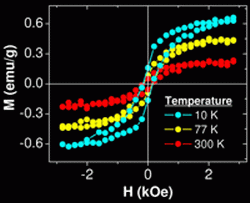Scientists Make Magnetic Silicon, Advancing Spin Based Computing

CNSE spintronics lab research shows silicon can maintain a permanent magnetic field above room temperature, which could help to develop more effective magnetic semiconductors and future spintronic devices
Scientists at the College of Nanoscale Science and Engineering at the University at Albany announced research that could lay the foundation for using silicon to develop chips with magnetic properties, potentially impacting the development of electron-spin-based or "spintronic" devices.
Image: Ferromagnetic hysteresis loops taken at three temperatures measured from the Mn implated Si.
Silicon is best known as the material used to make semiconductor computer chips with integrated circuits. Today, scientists at the College of Nanoscale Science and Engineering (CNSE) at the University at Albany published research that could lay the foundation for using silicon to develop chips with magnetic properties, potentially impacting the development of electron-spin-based or "spintronic" devices.
Spintronics exploits the quantum mechanical property of electron spin, as well as its charge state. Potential spintronics applications include magnetic random access memory (MRAM), which could enable the development of computing devices that are always on, don't require time to "boot up" and don't require a traditional hard drive.
While semiconductor materials such as silicon are utilized for memory and central processing units, the permanent information in computers is stored in magnetized hard drives which utilize the spin of the electron.. Recent research has discovered that a semiconductor can be made magnetic by doping it with an impurity such as Mn. The resulting material or diluted magnetic semiconductor (DMS) combines the properties of magnetism used in permanent information storage with that of semiconductor memory and logic devices. DMS spintronic devices have the potential to operate at considerably higher speeds and consume less power than conventional devices.
The research conducted by CNSE Professor Vincent LaBella and Martin Bolduc, CNSE post-doctorate fellow, shows for the first time that silicon can be made "ferromagnetic" or permanently magnetic up to 127 C, well above where conventional devices operate. The researchers achieved this by implanting Mn into silicon up to a concentration of 1% per atom.
LaBella and Bolduc are both specialists in spintronics research. LaBella was the first spintronics specialist to attempt to "magnetize" silicon, using tools at the Albany NanoTech complex, home to CNSE.
"The results are very exciting and open the door to silicon based spintronic devices that operate at or above room temperature," said LaBella. "The samples were fabricated using standard semiconductor processing equipment available at Albany NanoTech to quickly get results, which were significantly positive."
LaBella then joined forces with Bolduc for a more extensive experiment. The two implanted manganese into silicon in varying concentrations, then measured the magnetic properties with a SQUID magnetometer. They found the silicon was ferromagnetic above room temperature, or up to 127 degrees Celsius, opening up the possibility of its use in devices like personal computers, phones and PDAs. "These results indicate that the ferromagnetic exchange coupling in Si is very strong. Our future research is focused on understanding why this is so," said Bolduc.
The research paper, entitled Above Room Temperature Ferromagnetism in Mn-ion implanted Si, was published in Physical Review B. Bolduc was lead author on the paper.
Source: Albany NanoTech College of Nanoscale Science and Engineering
















